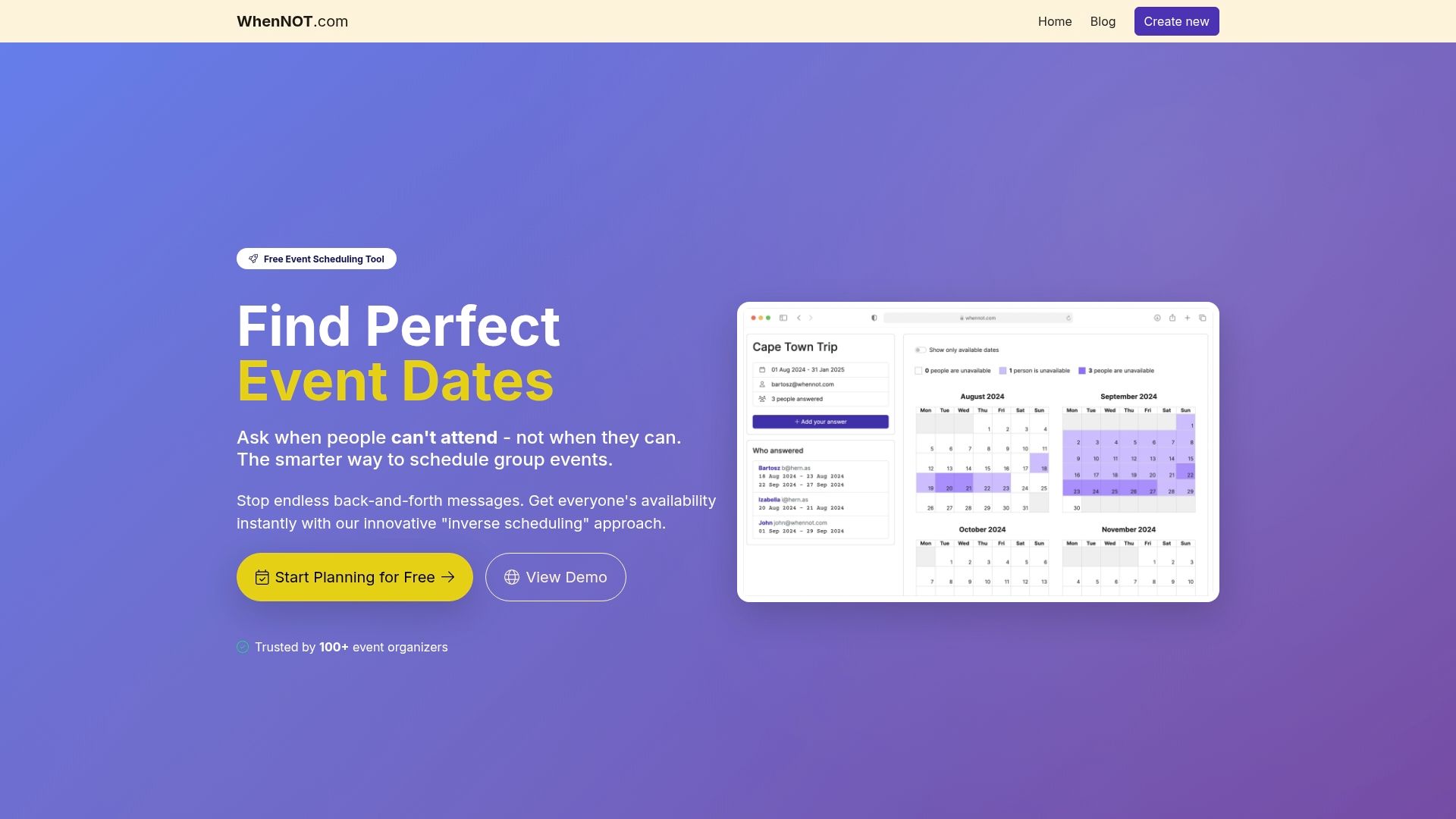Trying to pin down a time for a meeting can feel impossible when everyone is juggling busy calendars and endless messages. Studies show that inefficient scheduling leads to missed opportunities and reduced collaboration, costing organizations real results. Most people think the problem is not enough tech or tools. Actually, the biggest impact happens when you make the process effortless for everyone—sometimes all it takes is a focus on simplicity over complexity.
Table of Contents
- What Is User-Friendly Scheduling And Why It Matters
- Key Principles Of User-Friendly Scheduling
- Understanding Tools And Technology For Scheduling
- Impact Of User-Friendly Scheduling On Event Success
Quick Summary
| Takeaway | Explanation |
|---|---|
| Simplify the scheduling process. | Reduce complexity to minimize cognitive load for all participants. |
| Prioritize flexibility and accessibility. | Design systems that accommodate varied schedules and allow easy indication of availability. |
| Enhance transparency in coordination. | Utilize clear visualization tools to improve understanding of group availability and reduce confusion. |
| Leverage intelligent scheduling technologies. | Employ advanced tools that adapt to individual preferences and predict scheduling conflicts. |
| Focus on participant engagement. | Make scheduling effortless to enhance attendance and create a positive atmosphere for events. |
What is User-Friendly Scheduling and Why It Matters
User-friendly scheduling represents a strategic approach to coordinating events, meetings, and gatherings that prioritizes simplicity, accessibility, and participant convenience. At its core, defining user-friendly scheduling means creating a process that minimizes complexity and reduces potential communication barriers when multiple individuals need to align their availability.
The Fundamental Principles of User-Friendly Scheduling
Effective user-friendly scheduling hinges on several key principles that transform traditional scheduling methods. According to research from the National Center for Education Statistics, the primary goal is to develop systems that reduce cognitive load and streamline decision making. This means creating mechanisms that:
To clarify the essential aspects of user-friendly scheduling, the following table presents the fundamental principles discussed in the article and briefly explains each one.
| Principle | Explanation |
|---|---|
| Allow effortless communication of availability | Participants should be able to share when they are free with minimal steps. |
| Provide transparent visualization | Clearly show everyone the available scheduling options for easy group understanding. |
| Eliminate unnecessary steps | Remove redundant actions and complex forms to speed up the process. |
| Support flexible participation | Let people indicate availability without demanding strict commitments or undue time investment. |
| Minimize cognitive load | Make decisions simple and straightforward to reduce participant stress and confusion. |
- Allow participants to communicate availability with minimal effort
- Provide clear, transparent visualization of scheduling options
- Eliminate unnecessary steps or complicated input processes
- Support flexible participation without demanding extensive time commitment
Why Scheduling Complexity Matters
The implications of poor scheduling extend far beyond mere inconvenience. Complex scheduling processes can lead to significant productivity losses, communication breakdowns, and increased stress among participants. Inefficient scheduling can result in missed opportunities, decreased collaboration, and reduced overall group effectiveness.
When scheduling becomes user-friendly, it transforms from a potential source of frustration into a smooth, intuitive process. By reducing barriers to participation, organizations and groups can create more inclusive environments where everyone can contribute effectively. Medical research highlighting communication dynamics underscores how simplified scheduling mechanisms can dramatically improve group coordination and mutual understanding.
Ultimately, user-friendly scheduling is not just about finding a time—it's about creating a collaborative experience that respects individual constraints while achieving collective objectives. The most successful scheduling approaches recognize that time is a precious resource and design processes that make coordination feel effortless and intuitive.
Key Principles of User-Friendly Scheduling
User-friendly scheduling transcends basic time management by establishing a holistic framework that transforms how groups coordinate and communicate. The goal is to create an environment where scheduling becomes an effortless, intuitive process that respects individual needs while achieving collective objectives.
Simplicity and Accessibility
At the heart of user-friendly scheduling lies the principle of radical simplification. According to organizational communication research from Stanford University, successful scheduling solutions minimize cognitive friction by reducing complex decision-making steps. This means designing systems that are:
- Immediately understandable without extensive training
- Accessible across multiple devices and platforms
- Requiring minimal input from participants
- Capable of handling diverse scheduling scenarios
Simplicity does not mean sacrificing functionality. Instead, it means creating interfaces and processes that feel natural and require minimal mental effort to navigate. The most effective scheduling tools transform complex coordination challenges into straightforward, almost invisible interactions.
Flexibility and Participant-Centric Design
Flexibility represents another cornerstone of user-friendly scheduling. Traditional scheduling methods often force participants into rigid frameworks that ignore individual constraints. Modern approaches recognize that scheduling is fundamentally about human availability, not just calendar slots.
Research from MIT's Sloan School of Management highlights that truly user-friendly scheduling must accommodate varied personal schedules, work patterns, and time zone differences. This means developing systems that:
- Allow participants to indicate availability without strict commitments
- Support asynchronous communication
- Provide multiple input methods
- Automatically adjust for different time zones
Transparent and Inclusive Coordination
Transparency transforms scheduling from a transactional process into a collaborative experience. User-friendly scheduling tools should provide clear visualizations that help participants understand group availability instantly. This approach reduces uncertainty, minimizes back-and-forth communication, and creates a sense of shared understanding.
By prioritizing participant experience and reducing scheduling friction, organizations can create more connected, responsive, and efficient coordination mechanisms.
 The ultimate measure of user-friendly scheduling is not just finding a time—but making the entire process feel effortless and respectful of everyone involved.
The ultimate measure of user-friendly scheduling is not just finding a time—but making the entire process feel effortless and respectful of everyone involved.
Understanding Tools and Technology for Scheduling
Scheduling technologies have evolved dramatically, transforming from manual calendar management to sophisticated digital platforms that anticipate and streamline group coordination. These technological solutions represent a significant leap in how individuals and organizations manage time-related interactions.
Digital Evolution of Scheduling Technologies
According to cloud computing research from the University of Nevada, Las Vegas, modern scheduling tools leverage advanced technologies that go beyond simple time tracking. Digital scheduling platforms now incorporate artificial intelligence, machine learning, and complex integration capabilities that fundamentally reshape coordination processes.
Key technological advancements in scheduling tools include:
- Automated synchronization across multiple calendar platforms
- Real-time availability tracking
- Intelligent conflict detection and resolution
- Seamless cross-platform compatibility
Intelligent Features and Smart Coordination
Contemporary scheduling technologies are distinguished by their ability to understand and adapt to complex human scheduling needs. These systems do more than simply match open time slots—they analyze participant preferences, historical scheduling patterns, and contextual information to suggest optimal meeting times.
Intelligent scheduling technologies can:
- Predict potential scheduling conflicts before they occur
- Automatically adjust for different time zones
- Learn individual scheduling preferences over time
- Provide nuanced availability recommendations
Privacy and Security in Scheduling Technologies
As scheduling tools become more sophisticated, protecting participant data and maintaining privacy has become a critical technological consideration. Modern scheduling platforms implement robust security protocols that ensure personal information remains confidential while facilitating smooth coordination.
The most advanced scheduling technologies balance convenience with comprehensive data protection, using encryption, secure authentication methods, and transparent user controls. This approach ensures that while scheduling becomes increasingly automated and intelligent, individual privacy remains paramount.
Ultimately, scheduling technologies represent more than mere tools—they are sophisticated systems that transform how human groups communicate, collaborate, and coordinate their most valuable resource: time.
Impact of User-Friendly Scheduling on Event Success
User-friendly scheduling represents more than a technological convenience—it is a critical strategic approach that directly influences the success, engagement, and outcomes of group events. By reducing friction and complexity, these approaches transform how participants interact, commit, and ultimately participate in collective endeavors.
Enhancing Participation and Engagement
According to research from the National Institutes of Health, implementing user-friendly scheduling systems can dramatically increase event attendance and participation rates. The easier it is for individuals to confirm their availability, the more likely they are to commit and follow through.
Key factors driving increased participation include:

- Reduced cognitive load in scheduling processes
- Increased transparency of event planning
- Lower barriers to entry for event involvement
- Minimal time investment required for coordination
Psychological Dynamics of Scheduling
Beyond practical considerations, user-friendly scheduling touches fundamental psychological principles of group dynamics. When scheduling feels effortless, participants experience less stress and more positive anticipation about upcoming events. This emotional dimension significantly influences whether individuals will ultimately engage with the proposed gathering.
The psychological benefits manifest through:
The table below highlights the psychological benefits of implementing user-friendly scheduling, summarizing how these approaches influence participant attitudes and engagement.
| Psychological Benefit | Impact on Participants |
|---|---|
| Decreased decision-making anxiety | Reduces stress and hesitation in confirming attendance. |
| Enhanced sense of inclusivity | Helps everyone feel their constraints and needs are respected. |
| Improved perception of organization | Signals to participants that the event is well-managed and thoughtful. |
| Greater respect for time constraints | Increases satisfaction by showing consideration for individuals' schedules. |
- Decreased decision-making anxiety
- Enhanced sense of group inclusivity
- Improved perception of event organization
- Greater perceived respect for individual time constraints
Measuring Event Success through Scheduling Effectiveness
Successful events are not just about finding a time—they are about creating an environment where participation feels natural and uncomplicated. User-friendly scheduling serves as a critical first touchpoint that sets the tone for the entire event experience.
Organizations and groups that prioritize intuitive, flexible scheduling approaches consistently report higher levels of participant satisfaction, more diverse attendance, and more productive interactions. The scheduling process becomes a reflection of the event's overall quality and thoughtfulness.
Ultimately, user-friendly scheduling is an investment in human connection—transforming logistical challenges into opportunities for meaningful collaboration and shared experiences.
Experience Effortless Scheduling with WhenNOT
Does traditional event planning feel overwhelming because of complicated schedules and endless back-and-forth communication? In the article "Understanding Defining User-Friendly Scheduling for Events," the frustration of navigating rigid scheduling tools and coordination stress is clear. Many event organizers worry about confusion, repeated emails, and lengthy delays when trying to set dates that work for everyone. WhenNOT understands these pain points and offers a truly user-friendly scheduling approach that puts simplicity and participant convenience first. Instead of asking when people are available, our innovative tool lets you quickly see when your group is not busy. No sign-ups or account creation are required, so your guests can share their unavailable times easily and securely.

Ready to turn exhausting scheduling into a quick, seamless process? Discover how WhenNOT can help you find the best time for any multi-day event. Stop wasting time on complex planning and start visualizing the optimal date today. Try it free, enjoy privacy and simplicity, and take the stress out of event coordination by visiting https://whennot.com now.
Frequently Asked Questions
What is user-friendly scheduling?
User-friendly scheduling is a strategic approach to organizing events and meetings that prioritizes simplicity, accessibility, and convenience for all participants. It seeks to minimize complexity and reduce communication barriers when coordinating availability.
Why is user-friendly scheduling important for events?
User-friendly scheduling enhances participation and engagement by reducing friction in the scheduling process. It encourages more individuals to confirm their availability and commit to attending, which can lead to higher attendance rates and more successful events.
What are key principles of user-friendly scheduling?
Key principles include simplicity and accessibility, flexibility, and transparent coordination. These principles ensure that scheduling is straightforward, respects individual needs, and fosters a collaborative environment.
How do modern scheduling technologies improve the user-friendly experience?
Modern scheduling technologies utilize features like automated synchronization, real-time availability tracking, and intelligent conflict detection. These advancements help streamline the scheduling process, making it easier for participants to coordinate and communicate effectively.
